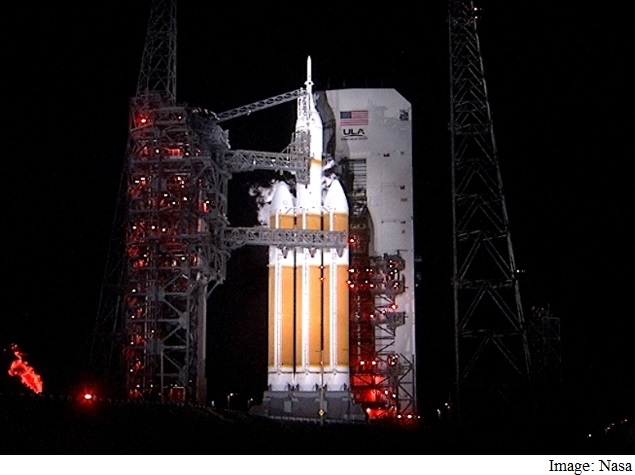- Home
- Science
- Science News
- Nasa's Orion Spacecraft Launched Successfully on Key Test Flight
Nasa's Orion Spacecraft Launched Successfully on Key Test Flight

The unmanned spacecraft soared to space at 7:05 am (1205 GMT) atop a United Launch Alliance Delta IV Heavy rocket that rumbled and roared as it climbed above the Florida coast at sunrise.
"I think it's a big day for the world, for people who know and love space," said Nasa administrator Charles Bolden.
The four-and-a-half hour flight aims to test crucial systems like the heat shield and parachute splashdown.
The launch is the first in more than 40 years of a US spacecraft intended to carry humans beyond the Moon. It has reinvigorated a US human exploration program that has been stagnant for more than three years since the last American space shuttle carried a crew of astronauts to the International Space Station.
The 30-year shuttle program ended in 2011, leaving the United States no other option but to pay Russia to carry astronauts on its Soyuz capsules at a cost of $71 million (roughly Rs. 438 crores) per seat.
Two loops
Friday's launch attempt aims to propel the Orion capsule into two loops around the Earth.
The first orbit is to be about as high as the International Space Station, which circles at an altitude of about 270 miles (430 kilometers), but the second would soar 15 times higher, to an apogee of 3,600 miles above the Earth.
Then, the spacecraft is supposed to plunge into the waters off San Diego, California to be retrieved by the US Navy.
An analysis of sophisticated sensors on the capsule should let Nasa know if the temperature inside remained survivable for a potential crew, even as the spacecraft's exterior heated to 4,000 degrees Fahrenheit (2,200 Celsius) during its re-entry to Earth's atmosphere at a velocity of 20,000 miles per hour.
Potential future missions for Orion, which can fit four people at a time, include a trip to lasso an asteroid and a journey to Mars by the 2030s.
Nasa has already spent $9.1 billion (roughly Rs. 56,183 crores) on Orion and the powerful rocket meant to propel it with crew on board, the Space Launch System (SLS).
Another unmanned test flight is slated for 2018. The first Orion test flight with people on board is scheduled for 2021, when total costs are projected to reach $19-22 billion (roughly Rs. 1,17,306 crores to Rs. 1,35,828 crores)..
About $370 million (roughly Rs. 2,284 crores) dollars in equipment is at stake in Friday's launch.
For the latest tech news and reviews, follow Gadgets 360 on X, Facebook, WhatsApp, Threads and Google News. For the latest videos on gadgets and tech, subscribe to our YouTube channel. If you want to know everything about top influencers, follow our in-house Who'sThat360 on Instagram and YouTube.
Related Stories
- Galaxy S24 Series
- MWC 2024
- Apple Vision Pro
- Oneplus 12
- iPhone 14
- Apple iPhone 15
- OnePlus Nord CE 3 Lite 5G
- iPhone 13
- Xiaomi 14 Pro
- Oppo Find N3
- Tecno Spark Go (2023)
- Realme V30
- Best Phones Under 25000
- Samsung Galaxy S24 Series
- Cryptocurrency
- iQoo 12
- Samsung Galaxy S24 Ultra
- Giottus
- Samsung Galaxy Z Flip 5
- Apple 'Scary Fast'
- Housefull 5
- GoPro Hero 12 Black Review
- Invincible Season 2
- JioGlass
- HD Ready TV
- Laptop Under 50000
- Smartwatch Under 10000
- Latest Mobile Phones
- Compare Phones
- Huawei Pura 70 Pro+
- Huawei Pura 70 Ultra
- Tecno Camon 30 Premier 5G
- Motorola Edge 50 Fusion
- Oppo A1i
- Oppo A1s
- Motorola Edge 50 Ultra
- Leica Leitz Phone 3
- Asus ZenBook Duo 2024 (UX8406)
- Dell Inspiron 14 Plus
- Realme Pad 2 Wi-Fi
- Redmi Pad Pro
- Cult Shock X
- Fire-Boltt Oracle
- Samsung Samsung Neo QLED 8K Smart TV QN800D
- Samsung Neo QLED 4K Smart TV (QN90D)
- Sony PlayStation 5 Slim Digital Edition
- Sony PlayStation 5 Slim
- Godrej 2 Ton 3 Star Inverter Split AC (SIC 24ITC3-WWA)
- IFB 1 Ton 2 Star Inverter Split AC (CI1322C113G1)

















